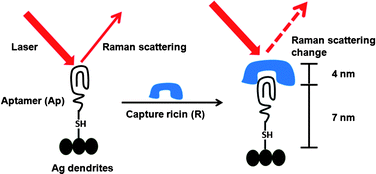A team of scientist from the US and India have developed a simple and sensitive way to detect ricin in liquid foods, such as orange juice and milk.

Theodore Labuza, at the University of Minnesota, and colleagues developed a two-step assay, in which the ricin was first captured out of food matrices by aptamer-conjugated silver dendrites and then the Raman spectrum was directly read on the silver dendrites. The measurement is based on the Raman ‘‘finger-print’’ of the target itself. Combined with the specific capture agent, Labuza says false positive results are extremely unlikely.
The assay shows great promise as a rapid (<40min), sensitive, and simple ‘‘Yes/No’’ method to detect bio-weapons, say the researchers.
Find out more for free by downloading Labuza’s Chemical Science Edge article.
Also of interest
ChemComm Surface Enhanced Raman Spectroscopy web themed issue










